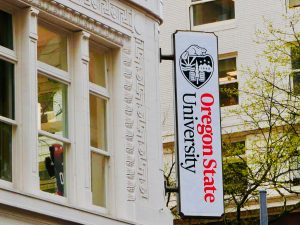Oregon State University has more than 570 hybrid-designated courses. These hybrid (“blended”) courses integrate regularly scheduled on-site classroom meetings with significant online, out-of-classroom components that replace regularly scheduled class meeting time. In this blended learning format, face-to face meeting time is generally reduced by 30 to 80% compared to a traditional on-campus course.
Hybrid courses range from large-enrollment general education courses to seminar-style graduate courses. Since 2012 when OSU formally established the hybrid course schedule type, the total enrollment in hybrid courses has exceeded 42,000 students.

Ecampus has recently expanded hybrid course offerings through the new OSU Portland Center, including undergraduate hybrid programs in business, psychology, cybersecurity and human development and family sciences. Portland-based graduate programs include the Master of Arts in Teaching, MBA and graduate certificate in business analytics.
As Susan Fein noted in the previous post, Blended Learning: What Dose the Research Show?, the literature provides a wealth of evidence for the efficacy of hybrid education. But what can instructors who design and teach hybrid courses tell us? Here are some valuable highlights from posts of the most recent Hybrid Faculty Learning Community cohort in the OSU Hybrid Faculty Blog. The members of this cohort were each engaged in the redesign of a more traditional on-campus course into a hybrid course that will be offered during the 2019-20 academic year.
Collaboration: Jillian St. Jacques – Applied Journalism: “Our students are thirsty to work with each other because it is stimulating, plain and simple. . . . They find their own interpersonal relationships incredibly exciting, as they agree, disagree, admire and/or square off with each other in the Arena of the Intellect.”
Creativity: Alina Padilla-Miller – New Media Communications: “Through activities, experiments and use of everyday media, there are a lot of opportunities to fold in the creation process. The process of creating is not only necessary to include in active learning but it’s also incredibly engaging and dare I say it, fun! Whether the class is face-to-face, online or hybrid, incorporating active learning will enrich the course and ultimately the student’s experience with the curriculum. Let the creating begin!”
Excitement: Susan Rodgers – Writing: “This is what’s exciting to me about the hybrid format: instead of simply assigning readings and hoping the students will come in prepared, they’ll do quizzes, discussions, and collaborations before they come to class . . . we can take the conversation very quickly to a deeper and more meaningful level during our f2f time.”

Flexibility: Dennis Adams – Business: “Students can more easily sort out the variance in their individual ability in this format. Students who require more time and exposure can reread/re-watch the material on their own time.”
Ownership: Michelle Maller – Forestry – “One of the most effective ways for a student to really master a concept is to present/teach that topic to their peers. . . . Creating ways for the students to interact with the content in a way that builds ownership of it can affect the overall learning. A good example of this is to use a discussion board to have each student “teach” their peers about a specific topic covered in that module.”
Roles: Irene Rolston – Anthropology: “Rather than students relying on their ‘sage’ to inform them, we have the ability to transform the classroom from unidirectional communication into multilateral communications between instructor to student and student to student. Approaching this from a hybrid design perspective, using the initial collection and deciphering of data online prior to use in the classroom as, for example, small group discussions, moves the omnipotent sage into the role of facilitator, one who directs the flow of the classroom rather than dominating the stage.”
Skills: Inara Scott – Business : “In a blended classroom, we have a unique opportunity to rethink the structure and content of our courses. . . . Rather than delivering content, we should be thinking about what unique skills we are building in students, and how we can engage them in the process of finding, interpreting, and creating their own content.”
To summarize, intentional hybrid course design and delivery afford opportunities for faculty to create engaging learning experiences that effectively interweave the classroom and online learning environments. This may involve rethinking the roles of the instructors and students, redesigning learning activities and even reconsidering learning outcomes to optimize the teaching-and-learning experience!
What are your perspectives on blended learning? How does this teaching modality compare to fully online or traditional classroom approaches?
Thank you!

